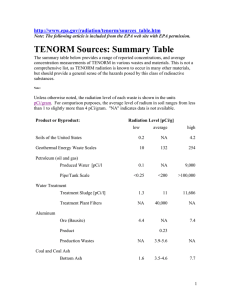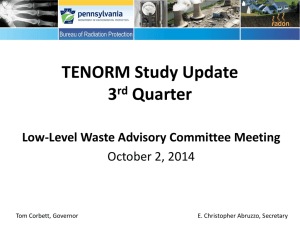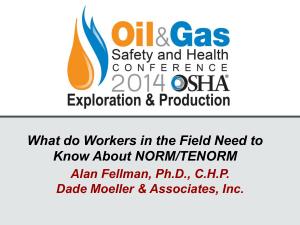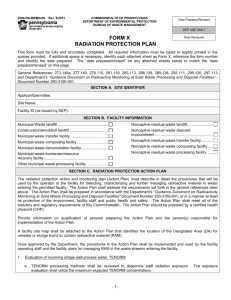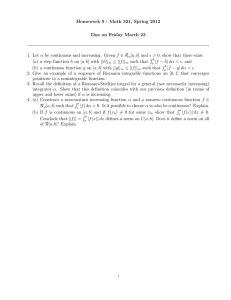Oil & Gas and Toxic Tort Alert Radioactive Materials
advertisement
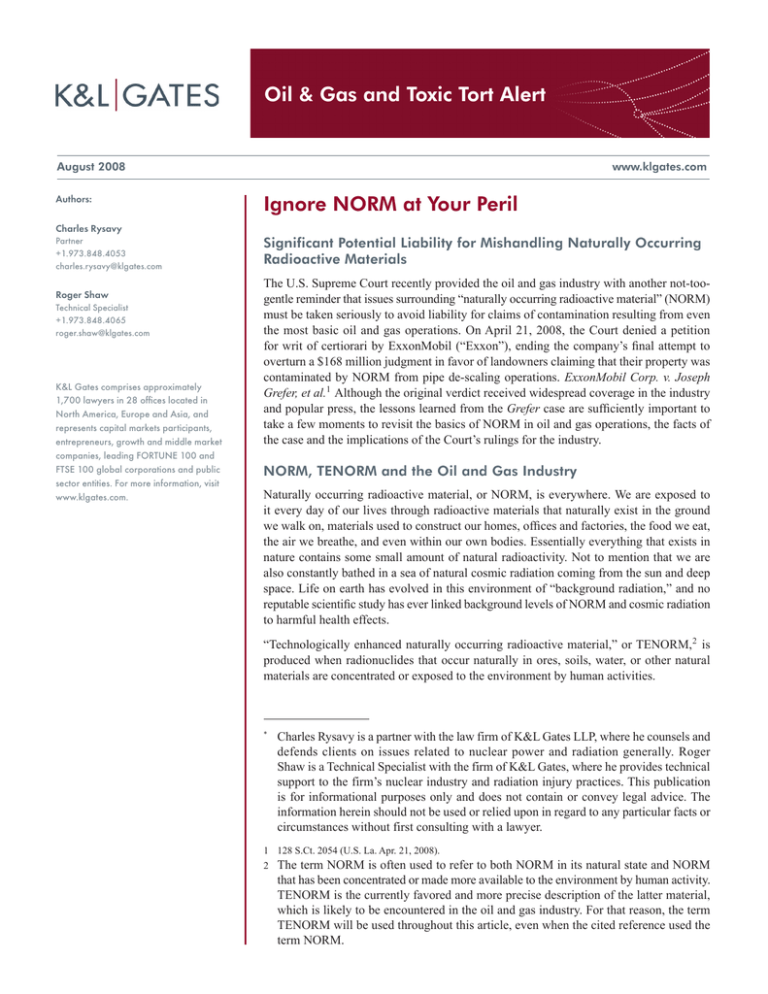
Oil & Gas and Toxic Tort Alert August 2008 Authors: www.klgates.com Ignore NORM at Your Peril Charles Rysavy Partner +1.973.848.4053 charles.rysavy@klgates.com Roger Shaw Technical Specialist +1.973.848.4065 roger.shaw@klgates.com K&L Gates comprises approximately 1,700 lawyers in 28 offices located in North America, Europe and Asia, and represents capital markets participants, entrepreneurs, growth and middle market companies, leading FORTUNE 100 and FTSE 100 global corporations and public sector entities. For more information, visit www.klgates.com. Significant Potential Liability for Mishandling Naturally Occurring Radioactive Materials The U.S. Supreme Court recently provided the oil and gas industry with another not-toogentle reminder that issues surrounding “naturally occurring radioactive material” (NORM) must be taken seriously to avoid liability for claims of contamination resulting from even the most basic oil and gas operations. On April 21, 2008, the Court denied a petition for writ of certiorari by ExxonMobil (“Exxon”), ending the company’s final attempt to overturn a $168 million judgment in favor of landowners claiming that their property was contaminated by NORM from pipe de-scaling operations. ExxonMobil Corp. v. Joseph Grefer, et al.1 Although the original verdict received widespread coverage in the industry and popular press, the lessons learned from the Grefer case are sufficiently important to take a few moments to revisit the basics of NORM in oil and gas operations, the facts of the case and the implications of the Court’s rulings for the industry. NORM, TENORM and the Oil and Gas Industry Naturally occurring radioactive material, or NORM, is everywhere. We are exposed to it every day of our lives through radioactive materials that naturally exist in the ground we walk on, materials used to construct our homes, offices and factories, the food we eat, the air we breathe, and even within our own bodies. Essentially everything that exists in nature contains some small amount of natural radioactivity. Not to mention that we are also constantly bathed in a sea of natural cosmic radiation coming from the sun and deep space. Life on earth has evolved in this environment of “background radiation,” and no reputable scientific study has ever linked background levels of NORM and cosmic radiation to harmful health effects. “Technologically enhanced naturally occurring radioactive material,” or TENORM,2 is produced when radionuclides that occur naturally in ores, soils, water, or other natural materials are concentrated or exposed to the environment by human activities. Charles Rysavy is a partner with the law firm of K&L Gates LLP, where he counsels and defends clients on issues related to nuclear power and radiation generally. Roger Shaw is a Technical Specialist with the firm of K&L Gates, where he provides technical support to the firm’s nuclear industry and radiation injury practices. This publication is for informational purposes only and does not contain or convey legal advice. The information herein should not be used or relied upon in regard to any particular facts or circumstances without first consulting with a lawyer. * 1 128 S.Ct. 2054 (U.S. La. Apr. 21, 2008). 2 The term NORM is often used to refer to both NORM in its natural state and NORM that has been concentrated or made more available to the environment by human activity. TENORM is the currently favored and more precise description of the latter material, which is likely to be encountered in the oil and gas industry. For that reason, the term TENORM will be used throughout this article, even when the cited reference used the term NORM. Oil & Gas and Toxic Tort Alert TENORM wastes are the radioactive residues from the extraction, treatment and purification of minerals, petroleum products, or other substances obtained from parent materials that may contain elevated concentrations of NORM. TENORM also includes any radioactive material in its natural concentration but made more accessible by human activities. According to the EPA, hundreds of millions of metric tons of TENORM wastes are generated each year from a wide variety of processes, ranging from uranium and phosphate mining to municipal drinking water treatment.3 NORM present in parent materials can become concentrated in the wastes during mining and beneficiation, mineral processing, oil and gas extraction, or various other processes, resulting in radionuclide concentrations in TENORM wastes that are often orders of magnitude higher than in the parent materials.4 Thus, radiation levels from TENORM can be increased sufficiently above background levels that they present a potential hazard to health and environment, and trigger state or federal regulatory requirements for human exposure and/or remediation. TENORM accumulates in elevated concentrations in oil and gas exploration and production waste streams primarily when radium isotopes naturally present in subsurface formations are dissolved and carried to the surface in the produced water. Oil and gas waste streams most likely to be contaminated by TENORM include produced water, scale and sludge. Production and processing equipment may also contain residual NORM. Minor amounts of radionuclides can also be transported as dissolved radium or radon in produced hydrocarbons, or nuclides in drill cuttings and drilling fluid. The amount of TENORM that accumulates in any oil and gas waste stream is dependent upon the amount of radionuclides present in the subsurface formation, formation fluid chemistry, extraction processes, treatment processes and age of production. Because most TENORM in oil and gas exploration and extraction is brought to the surface by produced water, the higher water production rate characteristic of older fields can result in higher concentrations of TENORM.5 3 United States Environmental Protection Agency, “About TENORM,” www.epa.gov/rpdweb00/ tenorm/about.html, July 17, 2008. 4 Id. 5 “An Overview of Naturally Occurring Radioactive Materials (NORM) in the Petroleum Industry,” The highest concentrations of oil and gas related TENORM is typically found in scale deposits, most frequently in equipment where produced water is handled or stored, such as water lines, flow lines, injection wellheads, vapor recovery units, water storage tanks, heaters/treaters and separators. In general, TENORM concentrations are highest in wellhead piping and in production piping near the wellhead. TENORM concentrations in sludge are generally much lower than in pipe scale.6 Natural gas production and processing equipment can also contain TENORM in the form of a radioactive isotope of lead, Pb-210, a long-lived daughter product of radium-222, which is sometimes produced along with natural gas. The gas plant equipment with the highest concentrations of Pb-210 includes reflux pumps, propane pumps and tanks, other pumps, and production lines.7 Equipment cleaned of scale, sludge or other forms of TENORM can be reused, but the cleaning process generates radioactive waste that requires proper disposal. Most scale is recovered from piping and other equipment by commercial facilities where the pipe and equipment is sent for cleaning, although some scale is removed at the well site during workover operations. Removal of scale has the potential to increase worker radiation exposure if not properly controlled. In addition, since recovered scale in the past was most often disposed of by spreading on land or burial, the soil at equipment cleaning yards and around some well sites may be heavily contaminated by TENORM.8 Grefer v. ExxonMobil The Facts The Grefer case involved a claim for property damage due to the presence of TENORM contamination on private property owned by the Grefer family and leased to Intracoastal Tubular Services, Inc. (“ITCO”), which conducted oil pipe de-scaling operations there under contract with Exxon. 9 ITCO began de-scaling United States Department of Energy, Environmental Assessment and Information Sciences Division, Argonne National Laboratory, p. 12 (1992). 6 Id. at 13-14. 7 Id. at 17. 8 Id. at 19. 9 Grefer v. Alpha Technical, 901 So. 2d 1117 (La.App. 4 Cir. 2005). August 2008 | 2 Oil & Gas and Toxic Tort Alert operations on the Grefer property in 1968. The evidence at trial indicated that Exxon first became aware of radioactive scale in drilling equipment in the North Sea when Occidental Petroleum made that discovery in 1981 and informed the other companies operating in the area. In April 1986, Chevron identified radium-226 in oilfield equipment in Mississippi, and shortly thereafter, Exxon undertook surveys of its own sites in Mississippi and made similar findings. In March 1987, Exxon representatives met with ITCO management and employees to discuss the NORM problem. Following the meeting, ITCO advised Exxon that it would no longer clean piping containing NORM, and some time thereafter, ITCO ceased all operations at the site. In 1996, testing on the property revealed radium contamination. In 1997, the Grefers filed suit against Exxon, ITCO and others for property damage, including loss of use and remediation of the property, as well as punitive damages.10 The Verdict After a five week trial, the jury returned a verdict in favor of the Grefers in the amount of $145,000 in general damages, $56 million in restoration costs, and $1 billion in punitive damages. The jury assessed 85% of the fault to Exxon, 5% of the fault to ITCO and the remaining 10% to two other defendants dismissed before trial.11 The Louisiana Court of Appeal’s Ruling Exxon raised several arguments on appeal, among them that the jury charge included no requirement of “reasonableness” for calculating compensatory damages, and that the $1 billion in punitive damages was unsupported by the evidence and unconstitutionally excessive.12 On the issue of compensatory damages, Exxon argued that the $56 million verdict was patently unreasonable because the Grefer property was valued at only $1.5 million.13 The Court of Appeal disagreed. Under the circumstances of this case, the Grefers were entitled to the cost of restoration, even if that cost far exceeded the value of the land and even though the damaged party could not be forced to use the award to remediate the 10Id. 11Id. 12Id. 13Id. at 1125-29. at 1129, 1135-36. at 1136. contaminated property.14 Although the court concluded that “a jury’s award of $56 million for restoration damages for a tract of land whose highest market value is $1.5 million certainly appears to be unreasonable,”15 it concluded that the jury did not abuse its discretion or manifestly err in the award because the plaintiffs “clearly . . . had both personal and economic reasons for wanting to restore their property to its original condition.”16 On the issue of whether the evidence supported the imposition of punitive damages, the court reasoned that the jury was entitled to conclude that Exxon’s conduct was “wanton and reckless” because it was on notice of the TENORM problem in 1981, even though there was no indication that Exxon was aware that the problem existed outside of the North Sea oil field until April 1986.17 The court further concluded that the jury could reasonably find Exxon’s conduct “wanton and reckless” because it waited ten months between the discovery of TENORM in domestic oil fields and notifying ITCO.18 This delay, the court reasoned, was “inexcusable” because, “[a]fter all, the ITCO employees were the persons handling the NORM contaminated piping/ tubulars on a daily basis and were most at risk, not Exxon’s executives.”19 Although this was purely a property damage case and it was undisputed that the plaintiffs had suffered only economic damages, in the Court of Appeals’ view “Exxon’s conduct . . . certainly evidenced an indifference or reckless disregard of the health and safety of others.”20 The court ultimately concluded, however, that the punitive damage award of $1 billion was neither reasonable nor proportionate to the wrong committed, such that it constituted an irrational and arbitrary deprivation of Exxon’s property.21 The court reduced the punitive damages to $112 million, or twice the general damage award.22 14Id. 15Id. 16Id. 17Id. 18Id. 19Id. 20Id. 21Id. 22Id. at 1137-39. at 1141 (emphasis added). at 1142. at 1145. at 1146-47. at 1148. at 1152. August 2008 | 3 Oil & Gas and Toxic Tort Alert The U.S. Supreme Court’s denial of certiorari in April closed the door on Exxon’s final avenue to appeal the verdict. Conclusion The prospect of substantial oil and gas exploration in plays not previously developed carries with it the prospects of new TENORM challenges. This seems particularly true where the Marcellus Shale play intersects with geologic deposits high in natural radioactivity, such as the Reading Prong, a geological formation in Eastern Pennsylvania, New York, New Jersey and Connecticut characterized by elevated levels of uranium and thorium. There and elsewhere, oil and gas industry participants would be well advised to undertake preventative efforts at the front end of their operations to detect and contain TENORM, and to establish action plans to address TENORM contamination when it occurs. As Grefer clearly counsels, anyone that fails to take such steps does so at its own - very substantial - peril. K&L Gates comprises multiple affiliated partnerships: a limited liability partnership with the full name K&L Gates LLP qualified in Delaware and maintaining offices throughout the U.S., in Berlin, in Beijing (K&L Gates LLP Beijing Representative Office), and in Shanghai (K&L Gates LLP Shanghai Representative Office); a limited liability partnership (also named K&L Gates LLP) incorporated in England and maintaining our London and Paris offices; a Taiwan general partnership (K&L Gates) which practices from our Taipei office; and a Hong Kong general partnership (K&L Gates, Solicitors) which practices from our Hong Kong office. K&L Gates maintains appropriate registrations in the jurisdictions in which its offices are located. A list of the partners in each entity is available for inspection at any K&L Gates office. This publication/newsletter is for informational purposes and does not contain or convey legal advice. The information herein should not be used or relied upon in regard to any particular facts or circumstances without first consulting a lawyer. Data Protection Act 1998—We may contact you from time to time with information on K&L Gates LLP seminars and with our regular newsletters, which may be of interest to you. We will not provide your details to any third parties. Please e-mail london@klgates.com if you would prefer not to receive this information. ©1996-2008 K&L Gates LLP. All Rights Reserved. August 2008 | 4
